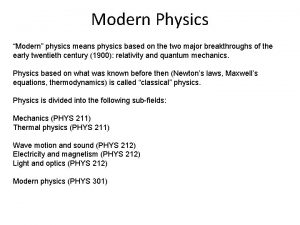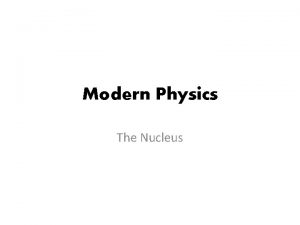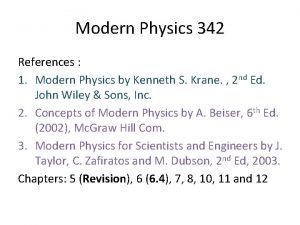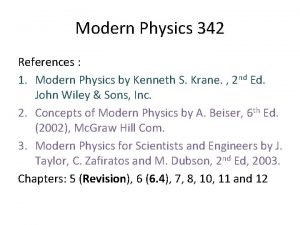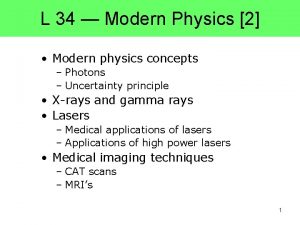Physics 334 Modern Physics Credits Material for this






























- Slides: 30

Physics 334 Modern Physics Credits: Material for this Power. Point was adopted from Rick Trebino’s lectures from Georgia Tech which were based on the textbook “Modern Physics” by Thornton and Rex. Many of the images have been used also from “Modern Physics” by Tipler and Llewellyn, others from a variety of sources (Power. Point clip art, Wikipedia encyclopedia etc), and contributions are noted wherever possible in the Power. Point file. The PDF handouts are intended for my Modern Physics class, as a study aid only.

Chapter 2 Statistics and Thermodynamics • • • Why Statistics Probability Distribution Gaussian Distribution Functions Temperature and Ideal Gas The Maxwell-Boltzmann Distribution Density of States

What has Statistics to do with Modern Physics In physics and engineering courses we talk about motion of baseballs, airplanes, rigid bodies etc. These descriptions are from a macroscopic point of view In Kinetic theory of gases, the macroscopic properties of gases for example, pressure, volume and temperature are based on microscopic motion of molecules and atoms that make up the gas. All matter is made of atoms and molecules, so it make sense to talk about macroscopic quantities in light of microscopic quantities. Therefore it is necessary to combine mechanics (classical or quantum) with statistics. This is called Statistical Mechanics. The main concept that will be used is the concept of probabilities, since in quantum mechanics the interest is in measuring the probabilities of a physical quantity (position, momentum, energy etc. )

Probability Distribution Function A distribution function f(x) or Ф(x) is a function that gives the probability of the particle found in a certain range of allowed values of an event. An event is an act of making a measurement of an observable. Say if our measurement is of position x than the probability function of finding the particle in the range x and x+dx is

Probability Calculations The probability of finding the particle is given by

Normalization The particle has to be some where. Normalization means that the sum or integral should be equal to 1.

Normalization Example: Find the normalizing constant A for the function

Expectation (Average) Value Average value of a physical quantity is called expectation value. If several measurements are made, the value that is expected on the average is the expectation value even though no single measurement may be the expectation value. This is also the mean value.

Expectation Value Example: Find the expectation value of the function

Standard Deviation Standard deviation (σ) tells us how much deviation to expect from the average value. Variance (σ2) also gives us the spread.

Gaussian Distribution Binomial distribution, Gaussian distribution and Poisson distribution are the most common distributions encountered in physics. We will discuss only the Gaussian distribution as it occurs widely and is used in many different fields. Gaussian distribution is also called Bell curve or standard distribution. Consider a drunk undergoing a random walk. Star t x

Gaussian Distribution Displacement is the sum of several random steps. The probability of small steps to cancel each other out is greater than the probability of large steps which might be in the same direction. The distribution function is given as

Bell Curve The solid green line shows that 1. The “most probable” value (peak) is at x=25 2. The median (50% level) is at x=25 3. The mean is at x=25 σ=6 Red dash line x- σ<x<x+σ The probability of the particle to be in this region is 68. 3% Purple dash line x- 2σ<x<x+2σ The probability of the particle to be in this region is 95%

Thermal Physics Thermal physics is the study of • • Temperature Heat How these affect matter How heat is transferred between systems and to the environment Heat It is a process in which energy is exchanged because of temperature differences. Thermal Contact Objects are said to be in thermal contact if energy can be exchanged between them. Thermal Equilibrium Energy cease to exchange between objects

Zeroth Law of Thermodynamics If objects A and B are separately in thermal equilibrium with a third object, C, then A and B are in thermal equilibrium with each other. Allows a definition of temperature Temperature is the property that determines whether or not an object is in thermal equilibrium with other objects

Thermometers Used to measure the temperature of an object or a system Make use of physical properties that change with temperature Many physical properties can be used volume of a liquid length of a solid pressure of a gas held at constant volume of a gas held at constant pressure electric resistance of a conductor color of a very hot object

Thermometers, cont A mercury thermometer is an example of a common thermometer The level of the mercury rises due to thermal expansion Temperature can be defined by the height of the mercury column

Temperature Scales Thermometers can be calibrated by placing them in thermal contact with an environment that remains at constant temperature Environment could be mixture of ice and water in thermal equilibrium Also commonly used is water and steam in thermal equilibrium

Celsius Scale Temperature of an ice-water mixture is defined as 0º C This is the freezing point of water Temperature of a water-steam mixture is defined as 100º C This is the boiling point of water Distance between these points is divided into 100 segments or degrees

Fahrenheit Scales Most common scale used in the US Temperature of the freezing point is 32º Temperature of the boiling point is 212º 180 divisions between the points

Kelvin Scale When the pressure of a gas goes to zero, its temperature is – 273. 15º C This temperature is called absolute zero This is the zero point of the Kelvin scale – 273. 15º C = 0 K To convert: TC = TK – 273. 15 The size of the degree in the Kelvin scale is the same as the size of a Celsius degree

Pressure-Temperature Graph All gases extrapolate to the same temperature at zero pressure This temperature is absolute zero

Modern Definition of Kelvin Scale Defined in terms of two points Agreed upon by International Committee on Weights and Measures in 1954 First point is absolute zero Second point is the triple point of water Triple point is the single point where water can exist as solid, liquid, and gas Single temperature and pressure Occurs at 0. 01º C and P = 4. 58 mm Hg

Modern Definition of Kelvin Scale, cont The temperature of the triple point on the Kelvin scale is 273. 16 K Therefore, the current definition of the Kelvin is defined as 1/273. 16 of the temperature of the triple point of water

Some Kelvin Temperatures Some representative Kelvin temperatures Note, this scale is logarithmic Absolute zero has never been reached

Comparing Temperature Scales

Converting Among Temperature Scales

Temperature and Kinetic Energy The average kinetic energy of a molecule in thermal equilibrium with its surrounding is given by Example Calculate the average kinetic energy of a gas molecule at room temperature T=20 degree Celsius It is useful to remember that at room temperature of 300 K the value of k. T is

Ideal Gas A gas does not have a fixed volume or pressure In a container, the gas expands to fill the container Most gases at room temperature and pressure behave approximately as an ideal gas. Exercise: Consider a container of gas that has a volume V in thermal equilibrium at a temperature T. Show that the pressure P is given by PV=Nk. T, where N is the Avogadro's number and k is the Boltzmann constant. Example: Calculate the volume occupied by one mole of molecules at a pressure of one atmosphere (1. 01 x 105 N/m 2) and a temperature of 273 K. This condition is called Standard Temperature and Pressure (STP)

Ideal Gas Example: Calculate the volume occupied by one mole of molecules at a pressure of one atmosphere (1. 01 x 105 N/m 2) and a temperature of 273 K. This condition is called Standard Temperature and Pressure (STP).
 Ceng334
Ceng334 Iat 334
Iat 334 Ceng 334
Ceng 334 Iat 334
Iat 334 334.edb. hkedcity. net/curriculum
334.edb. hkedcity. net/curriculum Love story 334
Love story 334 Iat 102
Iat 102 Adfa income limits
Adfa income limits Modern physics vs classical physics
Modern physics vs classical physics University physics with modern physics fifteenth edition
University physics with modern physics fifteenth edition Georgijev financial group
Georgijev financial group Vcu transfer center
Vcu transfer center Historic tax credits 101
Historic tax credits 101 Ects
Ects Combining new markets and historic tax credits
Combining new markets and historic tax credits Avrupa kredi transfer sistemi
Avrupa kredi transfer sistemi Unc transfer credit
Unc transfer credit Credits medical definition
Credits medical definition New market tax credits st louis
New market tax credits st louis The uniform customs and practice for documentary credits
The uniform customs and practice for documentary credits Scu transfer credits
Scu transfer credits Utep transfer credits
Utep transfer credits Nsqf credits
Nsqf credits Episd credits
Episd credits Edward scissorhands opening scene
Edward scissorhands opening scene Accrued expense balance sheet
Accrued expense balance sheet Is tufts liberal arts
Is tufts liberal arts Walking dead opening credits
Walking dead opening credits Debits and credits cheat sheet
Debits and credits cheat sheet Footings in t accounts
Footings in t accounts Jamestown clipart
Jamestown clipart








































